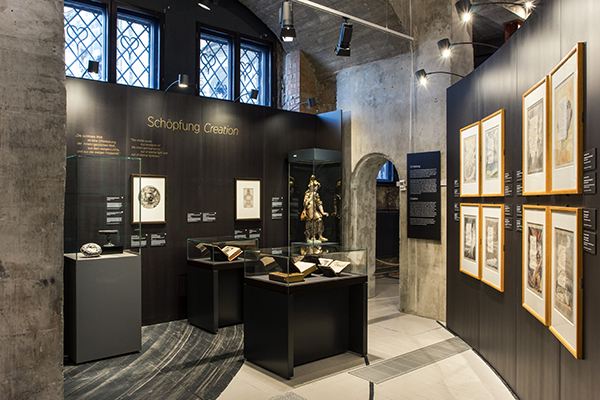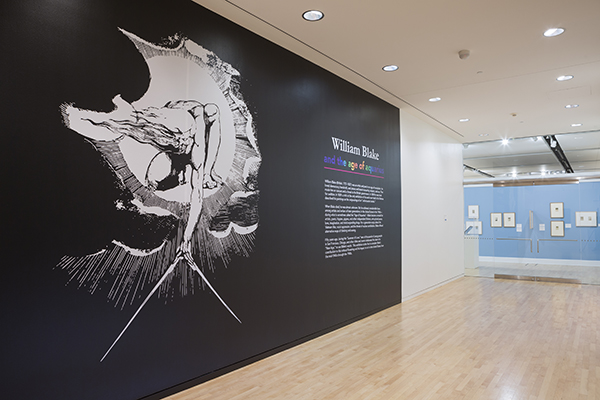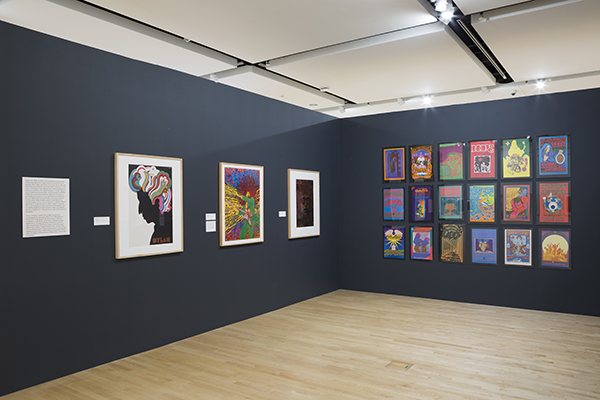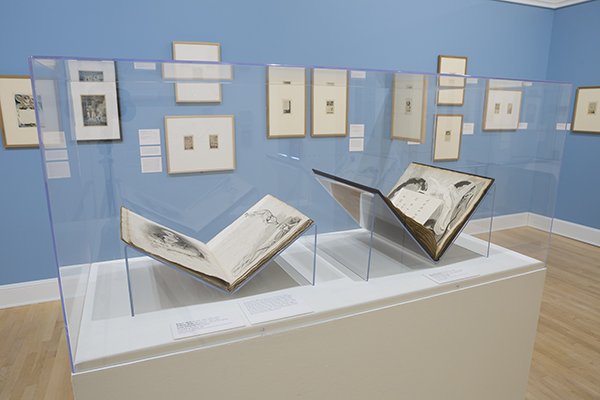Blake and Exhibitions, 2017
Luisa Calè (l.cale@bbk.ac.uk), Birkbeck, University of London, works on practices of reading, viewing, and collecting in the Romantic period. Her publications include Fuseli’s Milton Gallery: “Turning Readers into Spectators”; co-edited volumes on Dante on View: The Reception of Dante in the Visual and Performing Arts and Illustrations, Optics and Objects in Nineteenth-Century Literary and Visual Cultures; and special issues on “The Disorder of Things” (Eighteenth-Century Studies, 2011), “The Nineteenth-Century Digital Archive” (19: Interdisciplinary Studies in the Long Nineteenth Century, 2015), and “Literature and Sculpture at the Fin de Siècle” (Word and Image, 2018). Her current project, entitled The Book Unbound, explores practices of collecting and dismantling the book, with chapters on Walpole, Blake, and Dickens.
Every Morn & every Night
Some are Born to sweet delight
. . . . . . . . . . . . . . . . . .
Some are Born to Endless Night
(“Auguries of Innocence,” E 492, quoted in William Blake and the Age of Aquarius)
The works by Blake on display in 2017 span his trajectory from early modern esoteric traditions to his role as a critic of technology and power in late twentieth-century countercultures. An exhibition on the mystical philosophy of Jacob Böhme in Dresden featured some of Blake’s watercolor illustrations to Edward Young’s Night Thoughts among works tracing the reception of Böhme from the Corpus Hermeticum to Itten, Marc, Kandinsky, Arp, and the Bauhaus in the early twentieth century. The Blakes displayed in Dresden illustrated the planetary iconography of the late Nights of Young’s poem, the tension between light and darkness, and the earthly and heavenly possibilities of the human form. Seen in the context of the visual apparatus of the Corpus Hermeticum, they showed how Blake draws on early modern traditions that understand human beings as children of the planets, while also participating in the artisanal visual culture of hermeticism. By contrast, William Blake and the Age of Aquarius showed a selection from all periods of Blake’s work to illustrate his influence on postwar American artists, from experiments in printmaking to Robert Smithson, Maurice Sendak’s Where the Wild Things Are (1963), Allen Ginsberg and the Beat Generation, the Vietnam protests, and rock culture. The reception of Blake in music and popular culture was key to his inclusion in the final room of the Victoria and Albert Museum’s exhibition You Say You Want a Revolution? Records and Rebels, 1966–1970: Blake’s “Jerusalem” demonstrated how “dissent inspires protest across the centuries.” The information panel carefully tracked the legacy of the hymn as it was adopted by movements and parties across the political spectrum, from the suffragettes to Labour, Liberals, Liberal Democrats, and Conservatives. It also represented British identity in the 2012 London Olympics.
10 September 2016–26 February 2017
Victoria and Albert Museum, London
You Say You Want a Revolution? Records and Rebels, 1966–1970
The text of “Jerusalem,” displayed next to the lyrics of John Lennon’s “Imagine,” was the last object in the exhibition, celebrating its influence on the Beat Generation for its “evocation of the right to imagine, desire and fight for an idealised vision of society.”
Milton: A Poem in Two Books, copy A, plate 2, “Preface” (composed c. 1804–11, printed c. 1811).
British Museum registration number: 1859,0625.2.
1 April–1 October 2017
Birmingham Museum and Art Gallery, Birmingham
I Want! I Want! Art and Technology
For the Sexes: The Gates of Paradise, copy L, plate 9 [Bentley plate 11], “I want! I want!” (composed 1793 and revised c. 1820, printed c. 1825).
Fitzwilliam Museum, University of Cambridge, accession number: P.444-1985.
8 April–3 September 2017
Salisbury Museum, Salisbury
British Art: Ancient Landscapes
Jerusalem: The Emanation of the Giant Albion, copy A, plate 100, final full-plate illustration (composed c. 1804–20, printed c. 1820).
British Museum registration number: 1847,0318.93.100.
26 August–19 November 2017
Staatliche Kunstsammlungen, Dresden
Alles in Allem: Die Gedankenwelt des mystischen Philosophen Jacob Böhme
Exhibition catalogues: Alles in Allem: Die Gedankenwelt des mystischen Philosophen Jacob Böhme: Denken, Kontext, Wirkung. Ed. Claudia Brink and Lucinda Martin. Dresden: Sandstein Verlag für Staatliche Kunstsammlungen Dresden, 2017.
Grund und Ungrund: Der Kosmos des mystischen Philosophen Jacob Böhme. Ed. Claudia Brink and Lucinda Martin. Dresden: Sandstein Verlag für Staatliche Kunstsammlungen Dresden, 2017.
The Blakes are reproduced in the first volume and discussed in an essay by Luisa Calè, “William Blakes Nachtgedanken: Zwischen Buch, Körper und Kosmos” (151-65) (translated into German by Helen Jung).
This exhibition situated Blake’s Night Thoughts watercolors in the context of the paper culture of early modern mystical and esoteric publishing. In particular, handcrafted unique copies of Dionysius Andreas Freher’s illustrations from the Bibliotheca Philosophica Hermetica in Amsterdam include layers that can be lifted to reveal different stages in the transformations of man. Such material artifacts offer a counterpart to the layered pages of Blake’s Night Thoughts and to his envisioning one Zoa in the bosom of another in the late prophetic writings. Evidence of the circulation of Böhme and Freher manuscripts owned by the Royal Academician Richard Cosway and documented by Henry Crabb Robinson opens up paths for new research that could connect Blake and other artists to the paper arts and artisanal culture of hermeticism.

Illustration to Edward Young’s Night Thoughts, “The Christian Triumph,” frontispiece (c. 1795–97). Butlin #330.1.
British Museum registration number: 1929,0713.1 recto.
Illustration to Edward Young’s Night Thoughts, Night VI, page 15 (c. 1795–97). Butlin #330.236.
British Museum registration number: 1929,0713.119 recto.
Illustration to Edward Young’s Night Thoughts, Night VII, page 15 (c. 1795–97). Butlin #330.287.
British Museum registration number: 1929,0713.145 recto.
Illustration to Edward Young’s Night Thoughts, Night VIII, page 69 (c. 1795–97). Butlin #330.415.
British Museum registration number: 1929,0713.209 recto.
Illustration to Edward Young’s Night Thoughts, Night IX, page 29 (c. 1795–97). Butlin #330.447.
British Museum registration number: 1929,0713.225 recto.
Illustration to Edward Young’s Night Thoughts, Night IX, page 77 (c. 1795–97). Butlin #330.495.
British Museum registration number: 1929,0713.249 recto.
Illustration to Edward Young’s Night Thoughts, Night IX, page 83 (c. 1795–97). Butlin #330.501.
British Museum registration number: 1929,0713.252 recto.
Illustration to Edward Young’s Night Thoughts, Night IX, page 103 (c. 1795–97). Butlin #330.521.
British Museum registration number: 1929,0713.262 recto.
Milton: A Poem in Two Books, copy A, plate 4 (composed c. 1804–11, printed c. 1811).
British Museum registration number: 1859,0625.4.
21 September 2017–28 January 2018
British Museum, London
The Business of Prints
A print from Blake’s Illustrations of the Book of Job and the relevant copperplate illustrated a technical discussion of materials, practices, and techniques. The Blakes are reproduced in Antony Griffiths, The Print before Photography (London: British Museum, 2016) 29, which was the basis of the exhibition.
Illustrations of the Book of Job, plate 4, numbered “3”, in reverse, on the plate. Copperplate.
British Museum registration number: 1919,0528.16.
Illustrations of the Book of Job, plate 4, numbered “3” on the plate (composed 1823–26, printed 1826).
British Museum registration number: 1868,0822.3950.
23 September 2017–11 March 2018
Block Museum of Art, Northwestern University, Evanston, IL
William Blake and the Age of Aquarius

Exhibition catalogue: William Blake and the Age of Aquarius. Ed. Stephen F. Eisenman. Princeton: Princeton University Press and the Block Museum of Art, 2017.
This exhibition situated Blake’s work in the context of postwar printing experiments by Stanley William Hayter and Atelier 17, such as 21 Etchings and Poems (1960) with Willem de Kooning, Franz Kline, Irene Rice Pereira, Helen Phillips, and Attilio Salemme, and “Fifteen Poems, a Collaboration Using the Printing Methods of William Blake,” involving Alexander Calder and Helen Phillips. A section on the Doors of Perception featured Richard Anuszkiewicz’s Inward Eye serigraph series, as well as posters and other materials documenting the work of Bob Dylan, the Doors, and Jimi Hendrix.

America a Prophecy, copy M, plate 8 (composed 1793, printed c. 1807).
Yale Center for British Art, Paul Mellon Collection, B1992.8.2(8).
America a Prophecy, copy M, plate 9 (composed 1793, printed c. 1807).
Yale Center for British Art, Paul Mellon Collection, B1992.8.2(9).
America a Prophecy, copy M, plate 12 (composed 1793, printed c. 1807).
Yale Center for British Art, Paul Mellon Collection, B1992.8.2(12).
America a Prophecy, plate 1, frontispiece (composed 1793).
The Rosenbach, Philadelphia, 1954.0657.
Robert Blair, The Grave (London: R. H. Cromek, 1808). Quarto edition.
Charles Deering McCormick Library of Special Collections, Northwestern University.
Dante engravings (composed 1826–27, printed 1838 or 1892).
Charles Deering McCormick Library of Special Collections, Northwestern University.
Europe a Prophecy, plate 1, frontispiece (composed 1794, printed c. 1831–32 by Frederick Tatham).
The Rosenbach, Philadelphia, 1954.0658.
The First Book of Urizen, copy C, plate 6 [Bentley plate 5] (composed and printed 1794).
Yale Center for British Art, Paul Mellon Collection, B1978.43.1425.
The First Book of Urizen, copy C, plate 12 [Bentley plate 22] (composed and printed 1794).
Yale Center for British Art, Paul Mellon Collection, B1978.43.1431.
The First Book of Urizen, plate 1, title page (composed and printed 1794).
The Rosenbach, Philadelphia, 1954.0659.
Illustrations of the Book of Job, plates 1-22 (composed 1823–26, printed 1874).
Stephen F. Eisenman Collection.
The Number of the Beast Is 666 (c. 1805). Butlin #522.
The Rosenbach, Philadelphia, 1954.0011-D 1/6.
Songs of Innocence, copy G, plate 2 [Bentley plate 3], title page (composed and printed 1789).
Yale Center for British Art, Paul Mellon Collection, B1992.8.12(2).
Songs of Innocence, copy G, plate 14 [Bentley plate 25], “Infant Joy” (composed and printed 1789).
Yale Center for British Art, Paul Mellon Collection, B1992.8.12(9).
Songs of Innocence, copy G, plate 20 [Bentley plate 13], “The Little Boy Lost” (composed and printed 1789).
Yale Center for British Art, Paul Mellon Collection, B1992.8.12(12).
Songs of Innocence, copy G, plate 29 [Bentley plate 9], “The Little Black Boy” (composed and printed 1789).
Yale Center for British Art, Paul Mellon Collection, B1992.8.12(16).
Songs of Innocence, copy W, plate 8 [Bentley plate 12], “The Chimney Sweeper” (composed and printed 1789).
Charles Deering McCormick Library of Special Collections, Northwestern University.
Songs of Innocence, copy W, plate 13 [Bentley plate 20], “Night” (composed and printed 1789).
Charles Deering McCormick Library of Special Collections, Northwestern University.
Songs of Innocence, copy W, plate 14 [Bentley plate 21], “Night” (composed and printed 1789).
Charles Deering McCormick Library of Special Collections, Northwestern University.
Songs of Innocence, copy Y, plate 5 [Bentley plate 6], “The Ecchoing Green” (composed 1789, printed c. 1802).
Charles Deering McCormick Library of Special Collections, Northwestern University [see an image in Blake].
Songs of Innocence, copy Y, plate 6 [Bentley plate 7], “The Ecchoing Green” (composed 1789, printed c. 1802).
Charles Deering McCormick Library of Special Collections, Northwestern University [see an image in Blake].
Songs of Innocence and of Experience, copy F, plate 39 [Bentley plate 46], “London” (composed and printed 1789, 1794).
Yale Center for British Art, Paul Mellon Collection, B1978.43.1570.
Songs of Innocence and of Experience, copy F, plate 42, “The Tyger” (composed and printed 1789, 1794).
Yale Center for British Art, Paul Mellon Collection, B1978.43.1573.
John Gabriel Stedman, Narrative, of a Five Years’ Expedition (London: J. Johnson, 1796).
Charles Deering McCormick Library of Special Collections, Northwestern University.
Visions of the Daughters of Albion, copy H, plate 1, frontispiece (composed and printed 1793).
The Rosenbach, Philadelphia [see an image in the William Blake Archive].
Visions of the Daughters of Albion, copy H, plate 2, title page (composed and printed 1793).
The Rosenbach, Philadelphia [see an image in the William Blake Archive].
Visions of the Daughters of Albion, copy H, plate 4 (composed and printed 1793).
The Rosenbach, Philadelphia [see an image in the William Blake Archive].
Visions of the Daughters of Albion, copy H, plate 6 (composed and printed 1793).
The Rosenbach, Philadelphia [see an image in the William Blake Archive].
Visions of the Daughters of Albion, copy H, plate 9 (composed and printed 1793).
The Rosenbach, Philadelphia [see an image in the William Blake Archive].
Edward Young, The Complaint, and the Consolation; or, Night Thoughts (London: R. Edwards, 1797).
Charles Deering McCormick Library of Special Collections, Northwestern University.
